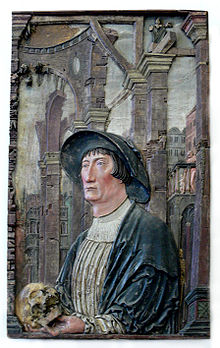| Revision as of 00:59, 2 May 2009 editSpace Cadet (talk | contribs)8,095 edits Undid revision 287353744 by Matthead (talk)← Previous edit | Revision as of 01:14, 2 May 2009 edit undoVolunteer Marek (talk | contribs)Autopatrolled, Extended confirmed users, Pending changes reviewers, Rollbackers94,171 edits removing duplicate infoNext edit → | ||
| Line 5: | Line 5: | ||
| At age 24, Giese (and ]) became a ] at the Catholic Church of ] and ], decades before Gdańsk and the church became ] when the ] of the ] was transformed into the ] in 1525. Giese was supported by Chancellor ]. | At age 24, Giese (and ]) became a ] at the Catholic Church of ] and ], decades before Gdańsk and the church became ] when the ] of the ] was transformed into the ] in 1525. Giese was supported by Chancellor ]. | ||
| Bishop Giese was a close friend of a the famous ] and proponent of ] ]. In 1516, he was the co-author, together with Copernicus, of a letter to the ] ] asking for the King's protection of Prussia against the ] and generally supported the interests of the Polish crown against that of the Teutonic Order. | Bishop Giese was a close friend of a the famous ] and proponent of ] ]. In 1516, he was the co-author, together with Copernicus, of a letter to the ] ] asking for the King's protection of Prussia against the ] and generally supported the interests of the Polish crown against that of the Teutonic Order. On July 1, 1536, he was designated by King Zygmunt, who considered him a very valuable diplomat, as Bishop of Culm, which was later confirmed by the Pope. | ||
| The Giese and the Kopernik family were related. Copernicus willed his writings to Giese and left his library to the church administration of Warmia. | The Giese and the Kopernik family were related. Copernicus willed his writings to Giese and left his library to the church administration of Warmia. | ||
| Giese was the coauthor of a letter to the Polish king ] which asked for protection against attacks carried out by the Teutonic Knights. He was a decided proponent of Polish influence in Warmia. On July 1, 1536, he was designated by King Zygmunt, who considered him a very valuable diplomat, as Bishop of Culm, which was later confirmed by the Pope. | |||
| He carried out active correspondence with ] of Rotterdam and ]. Among his known publications is ''Centrum et decem assertionum, quas autor earum Flosculos appelavit de homine interiore et exteriore'', a polemic with the proponent of Luther, ]. Most of his other works have been lost (including a work on ] and one called ''De Regno Christi''). | He carried out active correspondence with ] of Rotterdam and ]. Among his known publications is ''Centrum et decem assertionum, quas autor earum Flosculos appelavit de homine interiore et exteriore'', a polemic with the proponent of Luther, ]. Most of his other works have been lost (including a work on ] and one called ''De Regno Christi''). | ||
Revision as of 01:14, 2 May 2009

Tiedemann Giese (1 June 1480 – 23 October 1550, Lidzbark (Heilsberg) was a member of the patrician Giese family of Gdańsk. The brother of the Hanseatic League merchant Georg Giese and relative of Albrecht Giese he became Bishop of Chełmno (Culm) and finally Bishop of Warmia (Ermeland).
At age 24, Giese (and Mauritius Ferber) became a priest at the Catholic Church of St. Peter and St. Paul, decades before Gdańsk and the church became Protestant when the Ordenstaat of the Teutonic Knights was transformed into the Duchy of Prussia in 1525. Giese was supported by Chancellor Lucas David.
Bishop Giese was a close friend of a the famous astronomer and proponent of heliocentrism Nicolaus Copernicus. In 1516, he was the co-author, together with Copernicus, of a letter to the Polish King Sigismund I the Old asking for the King's protection of Prussia against the Teutonic Knights and generally supported the interests of the Polish crown against that of the Teutonic Order. On July 1, 1536, he was designated by King Zygmunt, who considered him a very valuable diplomat, as Bishop of Culm, which was later confirmed by the Pope.
The Giese and the Kopernik family were related. Copernicus willed his writings to Giese and left his library to the church administration of Warmia.
He carried out active correspondence with Erasmus of Rotterdam and Philipp Melanchthon. Among his known publications is Centrum et decem assertionum, quas autor earum Flosculos appelavit de homine interiore et exteriore, a polemic with the proponent of Luther, Johann Briesmann. Most of his other works have been lost (including a work on Aristotle and one called De Regno Christi).
Work
- Anacrisis nominis Jesus (1542)
- Antilogikon flosculorum Lutheranorum (1523)
References
- Teresa Borawska, Tiedemann Giese (1480-1550) w życiu wewnętrznym Warmii i Prus Królewskich [Tiedemann Giese (1480-1550) in the Internal Life of Warmia and Royal Prussia, Olsztyn, 1984.
| Catholic Church titles | ||
|---|---|---|
| Preceded byJohannes Dantiscus | Bishop of Warmia 1549-1550 |
Succeeded byStanislaus Hosius |
This article about a Catholic bishop is a stub. You can help Misplaced Pages by expanding it. |